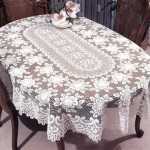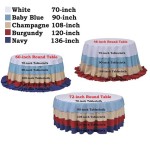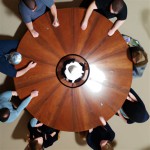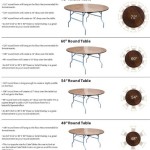Seating Plan Strategies for Round Tables
Round tables are a popular choice for various events, ranging from formal weddings and corporate galas to more casual parties and conferences. Their circular shape encourages conversation and fosters a sense of equality among seated guests. However, maximizing the benefits of round tables requires careful consideration of the seating plan. A well-executed seating plan contributes significantly to the overall enjoyment and success of the event, influencing guest interactions, networking opportunities, and the general atmosphere.
Creating a seating plan for round tables involves several factors, including guest dynamics, relationships, event objectives, and logistical constraints. Unlike linear table arrangements, round tables present unique challenges and opportunities for optimizing interaction. This article provides a comprehensive overview of strategies and considerations for developing effective seating plans using round tables.
Understanding the Advantages and Disadvantages of Round Tables
Round tables possess inherent advantages and disadvantages that impact seating plan design. The primary advantage is the enhanced conversational flow. Everyone at the table can see and interact with each other, fostering a sense of inclusivity. This makes round tables ideal for events that prioritize networking and social interaction. Guests are more likely to engage in discussions and build rapport when seated in a circular arrangement.
However, round tables also present some drawbacks. They require more floor space compared to rectangular tables to accommodate the same number of guests. This can be a limiting factor in smaller venues. Additionally, visual obstructions can be a concern. Centerpieces, floral arrangements, or tall decorative elements can hinder sightlines and impede conversation across the table. Care must be taken to choose centerpieces that are low enough to allow guests to see each other comfortably or high enough to allow them to see under it, or around it.
Another potential disadvantage is the potential for lopsided conversations. If certain guests are more dominant or talkative than others, they can monopolize the discussion and leave others feeling excluded. A well-thought-out seating plan can mitigate this risk by strategically placing guests who are likely to engage with one another and share similar interests.
Key Considerations in Creating a Round Table Seating Plan
Developing an effective seating plan for round tables involves a systematic approach. Several key considerations must be addressed to ensure a positive experience for all guests. These considerations encompass guest relationships, event objectives, and logistical constraints.
First and foremost, understanding guest relationships is crucial. Grouping guests who know each other and share common interests is a fundamental principle. This fosters immediate rapport and encourages comfortable conversation. Consider family ties, friendships, professional connections, and shared hobbies when assigning seats. Avoid seating individuals who have known conflicts or strained relationships at the same table.
Second, align the seating plan with the event objectives. If the primary goal is networking, strategically place individuals from different departments or organizations at the same table to facilitate cross-pollination of ideas. For a wedding, consider seating close family members and friends together, while also introducing guests who may not know each other but share common ground.
Third, account for logistical constraints. The layout of the venue, the size and number of tables, and the placement of key elements such as the stage, dance floor, and buffet stations all influence the seating plan. Ensure that guests have unobstructed views of the main event and easy access to essential amenities. Consider the proximity of tables to speakers, music, or other sources of noise, and adjust seating accordingly to minimize distractions.
Finally, special needs should be accommodated. Guests with disabilities may require specific seating arrangements to ensure their comfort and accessibility. Consider wheelchair access, proximity to restrooms, and reduced noise levels when assigning seats. Older guests may prefer to be seated away from loud music or heavy traffic areas.
Strategies for Optimizing Round Table Seating Arrangements
Beyond the fundamental considerations, several strategies can be employed to optimize round table seating arrangements and maximize the potential for positive interactions. These strategies focus on balancing guest dynamics, promoting inclusivity, and fostering a lively atmosphere.
One effective strategy is to strategically place individuals with outgoing personalities at each table. These individuals can act as catalysts, encouraging conversation and drawing out quieter guests. However, it is important to avoid placing too many dominant personalities at the same table, as this can lead to competition and imbalance.
Another strategy is to mix age groups and backgrounds. This can promote intergenerational dialogue and expose guests to diverse perspectives. However, ensure that there are sufficient common interests to facilitate meaningful conversation. Avoid creating situations where guests feel isolated or out of place.
Consider utilizing table assignments to introduce new connections. Strategically place guests who share professional interests but have not yet met. This can be a valuable networking opportunity and can lead to valuable collaborations. Provide conversation starters or icebreaker questions to help guests break the ice and initiate meaningful discussions.
Furthermore, avoid seating guests in isolated pairs. Even at round tables, a seating plan consisting primarily of couples can reduce the opportunities for mingling and networking. Aim to create groups of at least three or four individuals who are likely to engage with one another. This promotes a more dynamic and inclusive atmosphere.
Use visual cues to guide guests to their tables. Clearly display table numbers or names and provide escort cards with guests' names and table assignments. Consider incorporating a seating chart that is easily accessible and clearly visible to all guests. This can minimize confusion and streamline the seating process.
Consider using place cards to further refine the seating arrangement at each table. Place cards can be particularly useful for formal events or for strategically separating individuals who might be prone to conflict. They also add a touch of elegance and formality to the table setting.
Be prepared to make adjustments. Even the most meticulously planned seating arrangement may require last-minute changes. Be flexible and willing to accommodate unforeseen circumstances, such as cancellations or unexpected guest additions. Have a backup plan in place to address potential seating challenges.
Communicate the seating plan clearly to venue staff. Ensure that servers and other personnel are aware of the seating arrangements and any special needs that have been accommodated. This will help to ensure a smooth and seamless event experience for all guests.
Finally, after the event, solicit feedback from guests. This can provide valuable insights into the effectiveness of the seating plan and identify areas for improvement in future events. Ask guests whether they felt comfortable at their table, whether they had opportunities to interact with others, and whether they had any suggestions for future seating arrangements.
Creating a seating plan for round tables is an art and a science. It requires careful consideration of guest dynamics, event objectives, and logistical constraints. By following the strategies and guidelines outlined in this article, event planners can create seating arrangements that foster positive interactions, promote inclusivity, and contribute to the overall success of the event.
The implementation of these seating strategies can positively influence guest experiences and contribute to the overall success of various events. Consider the unique needs and goals of each specific event when tailoring the seating plan. By strategically assigning spaces at round tables, event planners can optimize social interactions and create a more enjoyable environment for everyone.

Free Table Seating Plan Templates

Seating Chart Maker Create Wedding Arrangements

Wedding Seating Plan Template Planner

Seating Plan Chart 90 Pax Round Wedding Table Display For Guest Names Draft Seat Planner Instant Printable Planning

I Ve Always Liked Round Tables This Is A Good Seating Guide To Diffe Sizes

16 Table Seating Chart Templates Doc Excel

Seating Chart Templates Estate Management Network

Wedding Seating Chart 80 Pax Round Table Display For Guest Names Organisation Planner Book Plan

Blank Wedding Seating Charts 10 Free Printables Printablee

Wedding Table Seating Plans
Related Posts








